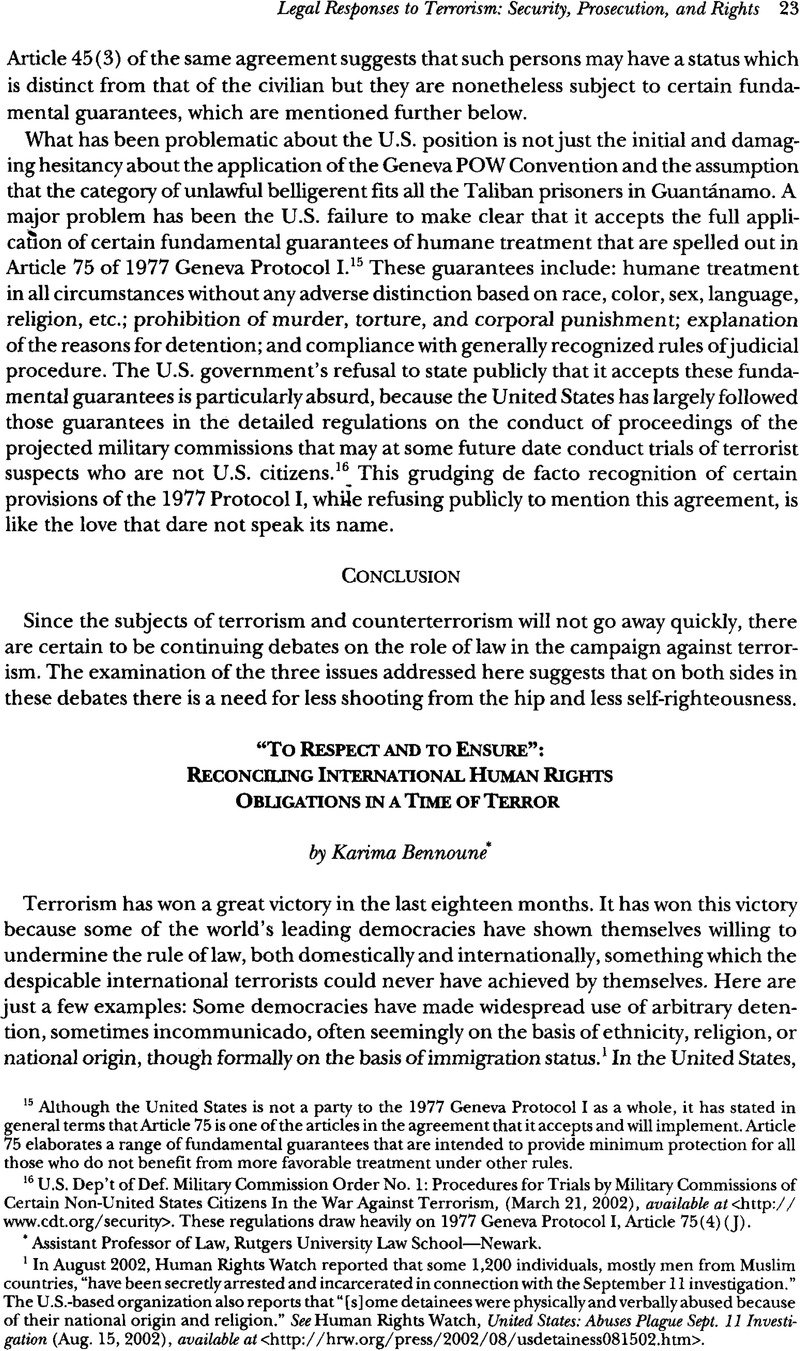No CrossRef data available.
Article contents
To Respect and to Ensure”: Reconciling International Human Rights Obligations in a Time of Terror
Published online by Cambridge University Press: 28 February 2017
Abstract

- Type
- Legal Responses to Terrorism: Security, Prosecution, and Rights
- Information
- Copyright
- Copyright © American Society of International Law 2003
References
1 In August 2002, Human Rights Watch reported that some 1,200 individuals, mostly men from Muslim countries, “have been secretly arrested and incarcerated in connection with the September 11 investigation.” The U.S.-based organization also reports that “[s]orne detainees were physically and verbally abused because of their national origin and religion.” See Human Rights Watch, United States: Abuses Plague Sept. 11 Investigation (Aug. 15, 2002), available at <http://hrw.org/press/2002/08/usdetainess081502.htm>.
2 See Blue Triangle Network, Fact Sheet: Stop the Repression Against Muslim, Arab and South Asian Immigrants, at <http://www.bluetriangle.org/HTMLobj-07/BTNfactsheetscreen.pdf>. While this seems like a hyperbole, it is interesting to note the language of the UN Declaration on the Protection of All Persons From Enforced Disappearance. In its preamble it describes a “disappearance,” in relevant part, as what happens “when persons are arrested (or) detained... by officials... followed by a refusal to disclose the fate or whereabouts of the persons concerned or a refusal to acknowledge the deprivation of their liberty, which places such persons outside the protection of the law.” Gares. 47/133 (Dec. 18,1992), available at <http://www.unhchr.ch/huridocda/huridoca.nsf/(Symbol)/A.RES.47.133.En?OpenDocument>.
3 See Alan M. Dershowttz, Why Terrorism Works 144 (2002). Dershowitz proposes a hypothetical situation in which what he calls a “ticking bomb terrorist” is interrogated. His justification is that “it is surely better to inflict nonlethal pain on one guilty terrorist who is illegally withholding information needed to preventan act of terrorism than to permit a large number of innocent victims to die.” Id. at 144. He never explains how we are to know ahead of time that a particular detainee is a “guilty terrorist” if he or she has not been convicted of an offense.
4 For example, the back cover of his book lists endorsements from, among others, Nobel Prize winner Elie Wiesel, former New York City Mayor Ed Koch, and even writer David Mamet.
5 Dana Priest & Barton Gellman, U.S. Decries Abuse but Defends Interrogations; ‘Stress and Duress’ Tactics Used on Terrorism Suspects Held in Secret Overseas Facilities, Wash. Post, Dec. 26, 2002, at A1.
6 Id.
7 Nat Hentoff, The American Way of Torture, Vill. Voice, Feb. 5, 2003, at 27 (citing Dana Priest & Barton Geltman, supra note 4).
8 Andrew Gumbel, America Admits Suspects Died in Interrogations, Indep., Mar. 7, 2003, at 12.
9 The Associated Press reported on March 10 that there had been “22 suicide attempts among detainees at the base, including 12 this year.” See Associated Press, Guantanamo Bay Detainee Attempts Suicide Again, Mar. 10, 2003, at <http://www.newsobserver.com/24hour/world/story/800819p-5708835c.html>. Part of the problem may be the indefinite nature of the detention.
10 Jonathan Alter, Time to Think About Torture, Newsweek, Nov. 5, 2001, at 45.
11 The Washington Post quoted one U.S. official who had been involved in this process as saying, “We don’t kick the (expletive) out of them. We send them to other countries so they can kick the (expletive) out of them.” Priest & Gellman, supra note 4.
12 Richard Perle, Thanh God for the Death of the UN, Guardian, Mar. 21, 2003, at 26; William Safíre, The Asian Front, N. Y. Times, Mar. 10, 2003, at A19.
13 This section of the paper was inspired by the discussion of formalist versus teleological approaches in Klabbers, Jan, Rebel with a Cause?: Terrorists and Humanitarian Law, 14 Eur. J. Int’l L. 299, 310 (2003)CrossRefGoogle Scholar.
14 Nagel, W.H., A Socio-legal View on the Suppression of Terrorists, 8 Int’l J. Soc. L. 213, 221 (1980)Google Scholar.
15 The relevant language from Article 2(1) sets out that: “Each State Party to the present Covenant undertakes to respect and to ensure to all individuals within its territory and subject to its jurisdiction the rights recognized in the present Covenant.” ICCPR, UN Gaor, 21st Sess., Supp. No. 16, at 52, art. 2(1) (1966), 999 UNTS 171 (entered into force Mar. 23, 1976).
16 Manfred Nowak, U.N. Covenant on Civil and Political Rights: CCPR Commentary 36 (1993).
17 Id.
18 Id.
19 See id. at 38.
20 Current Situation and Future of Human Rights, Sub-Commission on Human Rights Resolution 2002/2, para. 1 (Aug. 12,2002) (adopted without a vote).
21 Consequences for the Enjoyment of Human Rights of Acts of Violence Committed by Armed Groups that Spread Terror Among the Population and by Drug Traffickers, Sub-Commission on Human Rights Resolution 1993/13 (Aug. 26, 1993) (adopted without a vote).
22 Id., para. 2.
23 18 U.S.C. §2331 (2000).
24 N. Y. Times, Mar. 31, 2003, at C1.
25 The Al Qaeda Manual is available at <http://www.usdoj.gov/ag/trainingmanual.htm>.
26 James Drummond, Mubarak Fears War May Increase Terrorism, Fin. Times, Apr. 1, 2003, at 4.
27 See, e.g., Anne-Marie Slaughter, Good Reasons for Going around the UN: On the Brink of War, Int’l Herald Trib., Mar. 19, 2003, at) available at <http://www.iht.com/search/phppid=90176&owner=(IHT)&date=>.


